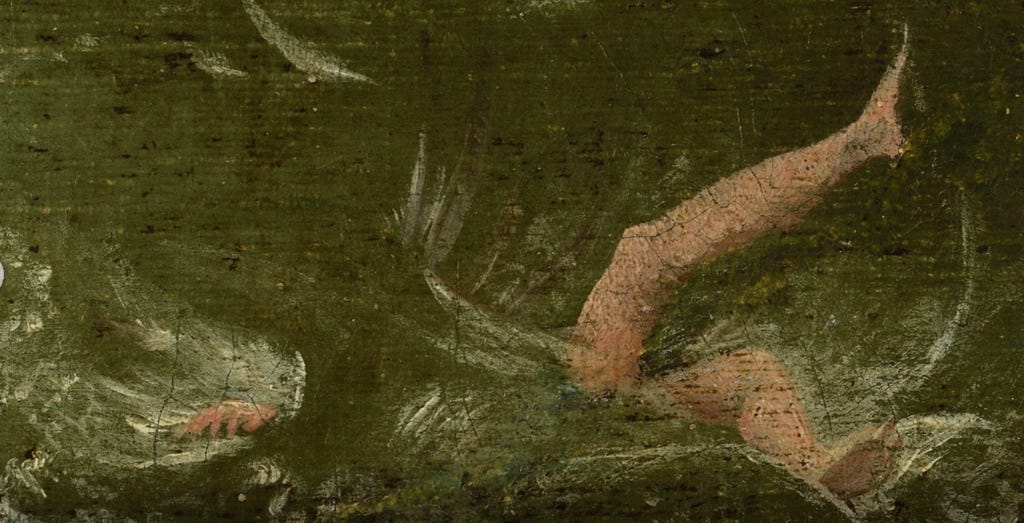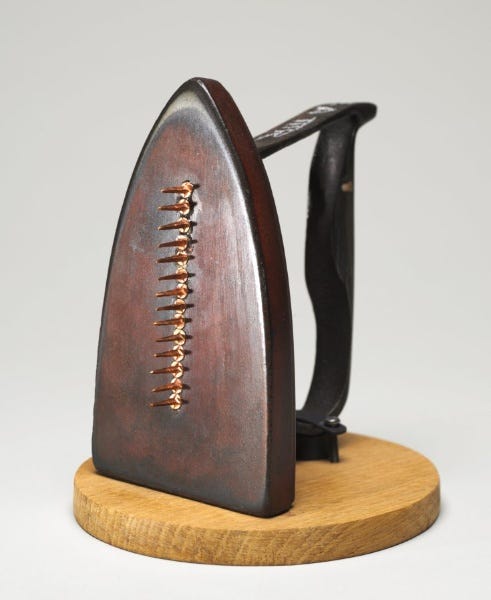landscape with loneliness
bruegel, murakami, man ray, and thinking through the dimensions of loneliness
cw: depression
The first time I came across the painting, I was 18 years old. I was profoundly depressed then, and had been for some time, and would continue to be for many years after. If you have any familiarity with depression, you may know how it can place a filter over every experience, throwing shadows across all the bright spots in your life.
Though the way I described it to a therapist at the time was quite the opposite. I told her that I felt like a curtain had been pulled back and I could now see the truth of everything in lightning-sharp clarity — all the ugly disgusting viscera of reality. I knew the truth, I told her. I was enlightened. People were cruel. Life was cruel. It was all endless. I felt that I alone possessed this secret knowledge that un-depressed people did not, and I was smug and possessive about it in only the way a lonely and depressed teenager who has dug herself into a self-loathing pit of perpetual wallowing is. My arrogance coated the humiliation of my banal suffering. In truth — and it is fair to say that I did not believe nor realize this at the time — I viewed the world as informed by my own depressed cynicism. All of art, literature, and life itself was changed by this outlook.
All this to say, when I first saw Pieter Bruegel’s Landscape with the Fall of Icarus, I viewed it through the darkest lens of my mind’s warped eye. I was lonely, so I saw loneliness. I saw isolation. I saw each man as a cruel and unfeeling island. I looked upon that cold landscape — with the red-shirted farmer and his downcast eyes, the incurious horse, the shepherd whose sheep leisurely grazed upon what seemed like nothing but dirt, the ship, the fisherman on the shore, and of course, that one blip on the canvas, Icarus’s miniscule feet thrashing in that green sea, and everyone ignoring his slow drowning — and I believed that it depicted the world exactly as I knew it to be. I saw in those brushstrokes a lonely unseen death, an uncaring world, and the way one fades into obscurity even in the midst of great tragedy. Even Icarus. Especially Icarus. A life foregrounded not even by his death, but by the ignorance of others. Foregrounded by a man in a bright ass red shirt. No one cared. He was alone.
It must be said that I have no background, formal or otherwise, in art history. I could not tell you the historical context of this painting, nor the techniques employed to paint it. I know vaguely that it has been restored over the years, suggesting that the original, hidden beneath so many layers, may not be at all what we now see today. Even who the original painter was is contested. I also know that there are two known versions of this painting with major differences that set them apart; chiefly, in one version, Icarus’s father Daedalus is depicted flying above the landscape and looking back at his fallen son. The one I had encountered and was enraptured by however was the one in which Daedalus was notably absent. Despite my lack of knowledge, no painting has ever captured me quite as much as this one has. It has become a great motif throughout my life, and as I’ve grown, my relationship with it has also evolved.
In the years following my first impression of Landscape, the painting lingered in my mind. There were moments during that time where I felt like I had finally beat the omnipresent sadness.1 These were periods of startling relief and clarity, when my head would break through the surface of the water and I could take in a big bright gulp of air. The tight strangulation of the filter would dissipate. Things felt a bit warmer. In those times, I would take another look at this familiar painting and feel and see something completely contrary to what I had previously. No one cares — what peace that thought brought now that I could see more clearly! I made the painting my laptop background for years. A reminder that even at your most embarrassing moments, your most catastrophic and legendary failures, no one would pay attention. No one cares.
But then I’d reconsider this thought process. I guess maybe I'd still want someone to care, after all. So I’d vacillate, alternating between the belief that I was alone, to the belief that I was alone.
A couple of years later when I was 20, I read a short story by Haruki Murakami from his collection, After the Quake.2 The story, titled “Landscape with Flatiron,” is meditative and melancholy. I saw a lot of myself in it.
“Landscape” follows a teenage girl, Junko, who has run away from her abusive home to a seaside town in Japan. There she meets a man from Kobe named Miyake, an artist of sorts who paints and has an obsession with (and proficiency in) building driftwood bonfires.3 The bulk of the story centers around a night at the beach. Junko and Miyake sit, smoke, drink, and watch a fire that Miyake has built. They sit at what seems like the precipice of the world, and there is a dissonant quality to the story that is both insular and cosmic in scope. Their conversations are heavy. They meander. They talk about life, death, premonitions, and Jack London. There is a latent intimacy in their vulnerability and in the way that they bare their hearts to one another slowly and tentatively, yet never fully; their language is cloaked under layers of symbols and metaphors. They are endlessly referential. Everything is talked about sideways, never head on.
Much like Miyake, Junko is enamored with fire. The flames “accepted all things in silence, drank them in, understood, and forgave. A family, a real family, was probably like this, she thought.” Junko’s loneliness seems both subdued and compounded by the flames. She is reminded of what true, bone-deep warmth feels like, but she is also reminded of her lack. In “Landscape with Flatiron,” the wild and natural entity of fire is tamed, domesticated, and enclosed. It is both free and controlled. It gives and takes. There is beauty in this duality for the protagonists.
There is a moment near the end of the story where Junko asks Miyake what painting he’s been working on. He hesitates, saying that it would be tough to explain, but after some more prodding, he relents. He tells her that his latest piece is a painting called Landscape with Flatiron.
“It’s just a picture of an iron in a room,” says Miyake.
Junko asks him why that would be tough to explain. He responds that “the iron is not really an iron.”
“It stands for something else?” Junko guesses. “Meaning you can only paint it if you use something else to stand for it?” He nods.
There is a brief pause here. Junko then confesses to Miyake that she feels completely empty. “There’s really nothing at all in here…I’m cleaned out. Empty,” she tells him.
I wondered about that sequence for a long time. Of course because it included the title, naturally suggesting the scene’s importance, but also because it felt personally meaningful.
What is the iron if not an iron? What is Icarus if not Icarus?
In 1921, Man Ray debuted his surrealist piece, Cadeau (Gift), a flatiron with fourteen brass tacks glued in a column down the center. Cadeau turns a domestic object regularly found in many homes and warps it, rendering it at once useless and dysfunctional with the smallest of changes. It becomes charged with a violent potential. The common household appliance transforms into a tool that can hurt, destroy, and take apart; it grows teeth. Or maybe, the tacks have simply made apparent the already violent potential that has always been dormant within the iron. They make legible what was always already there.
For me, depression was analogous. It was like the sudden gluing of brass tacks to my psyche and the world. But it wasn’t always clear to me how the tacks functioned. Did they make the world appear crueler, or did they make the already cruel world intelligible?
If the brass-tacked iron is a gift, it is a nasty one. If it is a gift, it is a distancing and isolating one.
Regardless, the landscape is undoubtedly changed by the flatiron.
Loneliness and emptiness abound in “Landscape with Flatiron,” and they abound in Landscape with the Fall of Icarus, too. And maybe in a certain sense, they also abound in Cadeau. I imagine Miyake and Junko sitting in the dark on that beach — that shadowy precipice of the world. The flames from their bonfire flicker out, embers glowing low and dark in a smoldering pile on the sand. The cold settles in. I imagine that across the dimensions of time, space, medium, culture, and language, a pair of pale white legs thrash in the sunlit water, just a few feet off the shore, unseen by bystanders. Somewhere else, under artificial gallery lights, Man Ray glues a bunch of tacks onto an iron and calls it a gift.
Depression is, of course, much more complex than just “sadness,” but I often called it that in my head. Maybe as a way to make it seem more manageable and less severe?
After the Quake is a collection of short stories set in the aftermath of the 1995 Kobe earthquake. Many of the stories approach the earthquake askance, exploring survivor’s guilt, and the social and ecological ramifications of a disaster.
There’s another character who I’m omitting called Keisuke. He’s irrelevant here.





Beautifully written ♥️
Beautiful as always! I loved all the connections you made here. Also wasn’t familiar with this painting and I’m so glad you’ve introduced me to it!